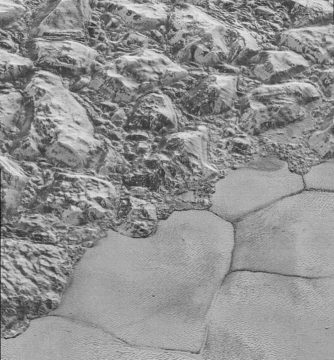Planetary scientists think they’ve found wind-built ripples of methane ice on the king of the Kuiper Belt.

NASA / JHU APL / SWRI
Dunes decorate many bodies in the solar system — not only our familiar Earth, but also Mars, Saturn’s moon Titan, and maybe even the nucleus of Comet 67P/Churyumov-Gerasimenko. Using the spectacular data that NASA’s New Horizons spacecraft sent back of Pluto’s surface after its 2015 flyby, researchers decided to look for dunes on that world, too. Reporting in the June 1st Science, Matt Telfer (University of Plymouth, UK) and colleagues think they’ve found them.
The team discovered a wide swath of parallel ripples on the western edge of Sputnik Planitia, the vast plain of molecular nitrogen (N2) at Pluto’s equator. This edge abuts the cordilleran Al-Idrisi Montes, which reach some 5 km (3 mi) into the Plutonian sky. The series of ripples runs largely parallel to the mountain-plain boundary and extend out from it for 75 km, eventually becoming gentler and fading out. This pattern is just what you’d expect if the ridges are dunes formed by wind coming off the mountains and sweeping across Sputnik Planitia.
But wind speeds are low on Pluto, reaching perhaps 10 m/s (20 mph) at the gustiest. Such breezes could certainly carry grains through the air once aloft, but it’s hard for them to pick grains up off the ground.
The team thinks Sputnik Planitia is to blame. Its molecular nitrogen ice sublimates in daily, intense bouts that could loft nearby grains. Once in the air, the grains would be caught by the wind and do a hopping dance across the surface, kicking up more grains and building undulating dunes. This bouncing process, called saltation, may explain dunes on Mars.
Spectral measurements by New Horizons indicate that this part of Sputnik Planitia has a heightened concentration of methane mixed in with the molecular nitrogen. Methane wouldn’t sublimate with the N2, but it could exacerbate the gasification: When sunlight heats the methane ice grains, their warmth would spread to the nearby nitrogen ice, accelerating the sublimation and freeing the gas that then launches the methane grains into the air. The grains’ rigidity (especially compared with the softer N2 ice) and size also makes them ideal participants in saltation and dune formation.
The methane likely migrates to the plain from the mountains, where it forms snowpacks. How long the dunes stay there once in place, however, is unclear. Given the time it takes Sputnik Planitia’s large, convecting cells of ice to turn over, the features can be no older than 500,000 years. It’s unclear if they're currently being eroded.
Sputnik Planitia’s glacier sheet comprises the largest deposit of molecular nitrogen on Pluto. This molecule has likely been with the dwarf planet since the world’s formation, Christopher Glein and J. Hunter Waite (Southwest Research Institute, San Antonio) suggest in the October 2018 Icarus. Given the amount of N2 Pluto has and how much it may have lost over time, the authors write, either the world coalesced with the nitrogen molecules directly out of the planet-forming solar nebula, or it picked up the N2 early on from impinging comets. Future tests of isotopic ratios — which would require another mission — could distinguish between these scenarios.
Below, you’ll find a video from the University of Plymouth, explaining how the dunes likely formed.
References:
Matt W. Telfer et al. “Dunes on Pluto.” Science. June 1, 2018.
Alexander G. Hayes. “Dunes Across the Solar System.” Science perspective piece. June 1, 2018.
Christopher R. Glein and J. Hunter Waite, Jr. “Primordial N2 provides a cosmochemical explanation for the existence of Sputnik Planitia, Pluto.” Icarus. October 2018.
Explore Sputnik Planitia and other Plutonian features with Sky & Telescope's Pluto globe.
 1
1








Comments
Peter Wilson
June 2, 2018 at 9:33 pm
The Sands of Pluto...
You must be logged in to post a comment.
You must be logged in to post a comment.